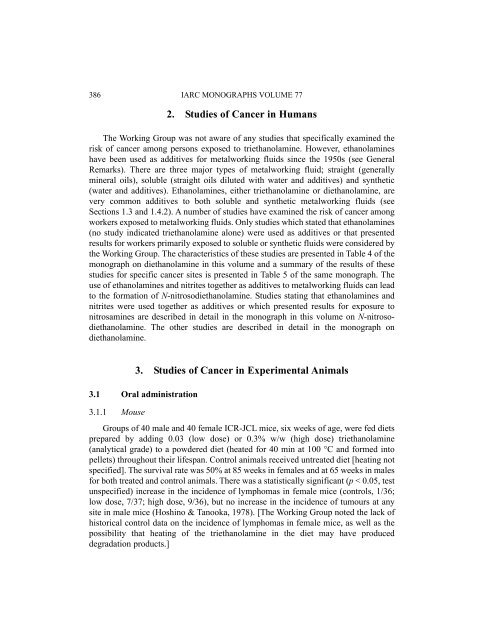TRIETHANOLAMINE 1. Exposure Data - IARC Monographs
TRIETHANOLAMINE 1. Exposure Data - IARC Monographs
TRIETHANOLAMINE 1. Exposure Data - IARC Monographs
Create successful ePaper yourself
Turn your PDF publications into a flip-book with our unique Google optimized e-Paper software.
386<br />
2. Studies of Cancer in Humans<br />
The Working Group was not aware of any studies that specifically examined the<br />
risk of cancer among persons exposed to triethanolamine. However, ethanolamines<br />
have been used as additives for metalworking fluids since the 1950s (see General<br />
Remarks). There are three major types of metalworking fluid; straight (generally<br />
mineral oils), soluble (straight oils diluted with water and additives) and synthetic<br />
(water and additives). Ethanolamines, either triethanolamine or diethanolamine, are<br />
very common additives to both soluble and synthetic metalworking fluids (see<br />
Sections <strong>1.</strong>3 and <strong>1.</strong>4.2). A number of studies have examined the risk of cancer among<br />
workers exposed to metalworking fluids. Only studies which stated that ethanolamines<br />
(no study indicated triethanolamine alone) were used as additives or that presented<br />
results for workers primarily exposed to soluble or synthetic fluids were considered by<br />
the Working Group. The characteristics of these studies are presented in Table 4 of the<br />
monograph on diethanolamine in this volume and a summary of the results of these<br />
studies for specific cancer sites is presented in Table 5 of the same monograph. The<br />
use of ethanolamines and nitrites together as additives to metalworking fluids can lead<br />
to the formation of N-nitrosodiethanolamine. Studies stating that ethanolamines and<br />
nitrites were used together as additives or which presented results for exposure to<br />
nitrosamines are described in detail in the monograph in this volume on N-nitrosodiethanolamine.<br />
The other studies are described in detail in the monograph on<br />
diethanolamine.<br />
3. Studies of Cancer in Experimental Animals<br />
3.1 Oral administration<br />
3.<strong>1.</strong>1 Mouse<br />
<strong>IARC</strong> MONOGRAPHS VOLUME 77<br />
Groups of 40 male and 40 female ICR-JCL mice, six weeks of age, were fed diets<br />
prepared by adding 0.03 (low dose) or 0.3% w/w (high dose) triethanolamine<br />
(analytical grade) to a powdered diet (heated for 40 min at 100 °C and formed into<br />
pellets) throughout their lifespan. Control animals received untreated diet [heating not<br />
specified]. The survival rate was 50% at 85 weeks in females and at 65 weeks in males<br />
for both treated and control animals. There was a statistically significant (p < 0.05, test<br />
unspecified) increase in the incidence of lymphomas in female mice (controls, 1/36;<br />
low dose, 7/37; high dose, 9/36), but no increase in the incidence of tumours at any<br />
site in male mice (Hoshino & Tanooka, 1978). [The Working Group noted the lack of<br />
historical control data on the incidence of lymphomas in female mice, as well as the<br />
possibility that heating of the triethanolamine in the diet may have produced<br />
degradation products.]
















